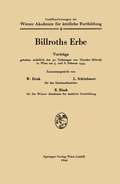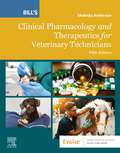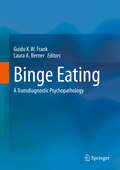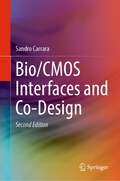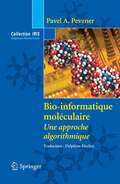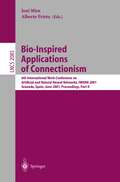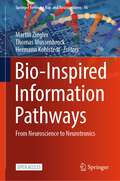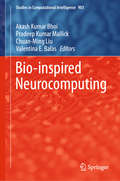- Table View
- List View
Billroths Erbe: (pdf) (Veröffentlichungen der Wiener Akademie für ärztliche Fortbildung #4)
by W. DenkBill's Clinical Pharmacology and Therapeutics for Veterinary Technicians - E-Book: Bill's Clinical Pharmacology and Therapeutics for Veterinary Technicians - E-Book
by Melinda AndersonBuild the skills you need to use drugs safely and avoid potential problems! Trusted by vet techs for 30 years, Bill's Clinical Pharmacology and Therapeutics for Veterinary Technicians helps you understand the principles and practice of pharmacology in treating different animal species. The text explains how drugs work, how they are administered, and how to calculate drug dosages. Covering drugs by body system, the book also explains possible abuses, mistakes, and how things can go wrong when therapeutic protocols are not properly implemented. From veterinary pharmacist and educator Melinda "Mindy" Anderson, this fifth edition helps you provide better care for your patients and better education for their owners. Content on basic pharmacology includes topics such as safety, terminology, pharmacy procedures, drug handling (including the latest OSHA requirements), dosage calculations, and pharmacokinetics. Chapter outlines, learning objectives, and key terms are provided at the beginning of each chapter, introducing you to the complex principles of pharmacology and guiding your study. Clear explanations of drugs help you understand the "how" and "why" behind drugs, their actions, their mechanisms, and adverse effects. Myths and Misconceptions, Ask Dr. Bill, and You Need to Know boxes spotlight key issues, concepts, and skills. Clinical applications link pharmacologic concepts to real-life situations. Review questions and critical thinking questions are included at the end of every chapter to help readers test their comprehension. Test questions and online quizzes enable self-assessment and help you prepare for classroom and certification exams. NEW Veterinary Feed Directives section reflects the newest FDA guidelines on medicated feed for animals. NEW! Updated drug information includes all drug categories as well as new information on several drugs. NEW! Additional full-color images make it easier to understand pharmacology concepts. NEW! Updated test questions and drug calculation exercises on the Evolve website make study and review easier and reinforce your understanding of difficult subject matter.
Bills of Health
by Richard LawsonWhy is it that NHS workers are continually complaining that the service is underfunded while the Government claims that it is increasing NHS funding year on year in real terms? Is someone being economical with the truth or is there a deeper explanation? Richard Lawson shows that at least one fifth of the NHS clinical budget is spent on trying to cure illness caused by unemployment poverty bad housing and environmental pollution. The NHS has been falling behind in the race to keep up with deteriorating health caused by worsening social and environmental conditions. Bills of Health offers treatment as well as diagnosis. It identifies what needs to be done to rectify the causes of our ill-health and how this could be achieved through the creation of between one and two million jobs in the UK. Jobs that include worthwhile work in housing public transport and environmental protection as well as caring for people. Bills of Health draws up balance sheets that show not only can we afford to finance this work - but that we cannot afford not to.
Bills of Health
by Richard LawsonWhy is it that NHS workers are continually complaining that the service is underfunded while the Government claims that it is increasing NHS funding year on year in real terms? Is someone being economical with the truth or is there a deeper explanation? Richard Lawson shows that at least one fifth of the NHS clinical budget is spent on trying to cure illness caused by unemployment poverty bad housing and environmental pollution. The NHS has been falling behind in the race to keep up with deteriorating health caused by worsening social and environmental conditions. Bills of Health offers treatment as well as diagnosis. It identifies what needs to be done to rectify the causes of our ill-health and how this could be achieved through the creation of between one and two million jobs in the UK. Jobs that include worthwhile work in housing public transport and environmental protection as well as caring for people. Bills of Health draws up balance sheets that show not only can we afford to finance this work - but that we cannot afford not to.
Binan Goonj: Bridging cultures in Aboriginal health
by Anne-Katrin Eckermann Toni Dowd Ena Chong Lynette Nixon Roy Gray Sally Margaret JohnsonA newly-updated edition of the definitive textbook on Aboriginal Health issues Binan Goonj, 3rd Edition: Bridging cultures in Aboriginal health is a comprehensive Indigenous health text which addresses key topics in a clear and accessible manner. Thoroughly updated and revised, the latest edition of Binan Goonj sheds light upon the many multidisciplinary topics within the complex field of Indigenous health. With chapter titles including Empowerment in Aboriginal Health and Aboriginal Communities Today, this authoritative health resource has been widely adopted as a teaching text across Australia. Despite years of research, policy changes and interventions, it is widely documented that the health status of many Aboriginal people remains the poorest in Australia. Binan Goonj, 3rd Edition: Bridging cultures in Aboriginal health explores the processes and practices underlying this situation, while providing practical strategies to work towards redressing it. This latest edition will engage a diverse readership and challenge students and health professionals alike to examine their own values and the use of power in Australian society. Elsevier’s Evolve website provides extensive support material for nursing and health professions faculty and students, including: • discussion questions • suggested reading on Aboriginal health and related topics • web links • an instructor’s manual featuring course delivery tips including topics such as adult learning, attitudinal change, colonisation, government policies, Indigenous media sites and cross-cultural education resources • video links specific to chapters in this latest edition of Binan Goonj • completely updated to reflect major Indigenous health policy changes since the second edition• an in-depth exploration of the collaboration between Aboriginal and non-Aboriginal people• the use of Aboriginal health case studies and critical incidences to bring academic discussion and analysis to life• processes that have been successfully incorporated into 18 years of cross-cultural workshops
Binary Data Analysis of Randomized Clinical Trials with Noncompliance (Statistics in Practice #99)
by Kung-Jong LuiIt is quite common in a randomized clinical trial (RCT) to encounter patients who do not comply with their assigned treatment. Since noncompliance often occurs non-randomly, the commonly-used approaches, including both the as-treated (AT) and as-protocol (AP) analysis, and the intent-to-treat (ITT) (or as-randomized) analysis, are all well known to possibly produce a biased inference of the treatment efficacy. This book provides a systematic and organized approach to analyzing data for RCTs with noncompliance under the most frequently-encountered situations. These include parallel sampling, stratified sampling, cluster sampling, parallel sampling with subsequent missing outcomes, and a series of dependent Bernoulli sampling for repeated measurements. The author provides a comprehensive approach by using contingency tables to illustrate the latent probability structure of observed data. Using real-life examples, computer-simulated data and exercises in each chapter, the book illustrates the underlying theory in an accessible, and easy to understand way. Key features: Consort-flow diagrams and numerical examples are used to illustrate the bias of commonly used approaches, such as, AT analysis, AP analysis and ITT analysis for a RCT with noncompliance. Real-life examples are used throughout the book to explain the practical usefulness of test procedures and estimators. Each chapter is self-contained, allowing the book to be used as a reference source. Includes SAS programs which can be easily modified in calculating the required sample size. Biostatisticians, clinicians, researchers and data analysts working in pharmaceutical industries will benefit from this book. This text can also be used as supplemental material for a course focusing on clinical statistics or experimental trials in epidemiology, psychology and sociology.
Binary Data Analysis of Randomized Clinical Trials with Noncompliance
by Kung-Jong LuiIt is quite common in a randomized clinical trial (RCT) to encounter patients who do not comply with their assigned treatment. Since noncompliance often occurs non-randomly, the commonly-used approaches, including both the as-treated (AT) and as-protocol (AP) analysis, and the intent-to-treat (ITT) (or as-randomized) analysis, are all well known to possibly produce a biased inference of the treatment efficacy. This book provides a systematic and organized approach to analyzing data for RCTs with noncompliance under the most frequently-encountered situations. These include parallel sampling, stratified sampling, cluster sampling, parallel sampling with subsequent missing outcomes, and a series of dependent Bernoulli sampling for repeated measurements. The author provides a comprehensive approach by using contingency tables to illustrate the latent probability structure of observed data. Using real-life examples, computer-simulated data and exercises in each chapter, the book illustrates the underlying theory in an accessible, and easy to understand way. Key features: Consort-flow diagrams and numerical examples are used to illustrate the bias of commonly used approaches, such as, AT analysis, AP analysis and ITT analysis for a RCT with noncompliance. Real-life examples are used throughout the book to explain the practical usefulness of test procedures and estimators. Each chapter is self-contained, allowing the book to be used as a reference source. Includes SAS programs which can be easily modified in calculating the required sample size. Biostatisticians, clinicians, researchers and data analysts working in pharmaceutical industries will benefit from this book. This text can also be used as supplemental material for a course focusing on clinical statistics or experimental trials in epidemiology, psychology and sociology.
Binaural Hearing: With 93 Illustrations (Springer Handbook of Auditory Research #73)
by Arthur N. Popper Richard R. Fay Ruth Y. Litovsky Matthew J. GoupellThe field of Binaural Hearing involves studies of auditory perception, physiology, and modeling, including normal and abnormal aspects of the system. Binaural processes involved in both sound localization and speech unmasking have gained a broader interest and have received growing attention in the published literature. The field has undergone some significant changes. There is now a much richer understanding of the many aspects that comprising binaural processing, its role in development, and in success and limitations of hearing-aid and cochlear-implant users.The goal of this volume is to provide an up-to-date reference on the developments and novel ideas in the field of binaural hearing. The primary readership for the volume is expected to be academic specialists in the diverse fields that connect with psychoacoustics, neuroscience, engineering, psychology, audiology, and cochlear implants. This volume will serve as an important resource by way of introduction to the field, in particular for graduate students, postdoctoral scholars, the faculty who train them and clinicians.
Binde- und Stützgewebe: Morphologische und Biochemische Informationen (Der Rheumatismus #37)
by H. Bartelheimer N. DettmerBinge Eating: A Transdiagnostic Psychopathology
by Guido K. W. Frank Laura A. BernerThis book provides a comprehensive overview of our current understanding of binge eating, which is characterized by the uncontrollable consumption of large amounts of food in a discrete time period. Written by experts on eating disorders, it first introduces the phenotype of binge eating, including its epidemiology and assessment. It then describes the underlying neurobiological alterations, drawing on cutting-edge animal models and human studies to do so. In addition, it extensively discusses current treatment models, including medication, psychotherapy, self-interventions and disease prevention. Lastly, an outlook on the future research agenda rounds out the coverage. Given binge eating’s current status as an under-researched symptom, but one shared across many eating disorders, this book provides an up-to-date, integrative and comprehensive synthesis of recent research and offers a valuable reference for scientists and clinicians alike.
Bio-Applications of Nanoparticles (Advances in Experimental Medicine and Biology #620)
by Warren C. W. ChanThis edited book highlights the central players in the Bionanotechnology field - which are the nanostructures and biomolecules. It provides broad examples of current developments in Bionanotechnology research and is an excellent introduction to the field. The book describes how nanostructures are synthesized and details the wide variety of nanostructures available for biological research and applications. Examples of the unique properties of nanostructures are provided along with the current applications of these nanostructures in biology and medicine. The final chapters of the book describe the toxicity of nanostructures.
Bio-Based Materials as Applicable, Accessible, and Affordable Healthcare Solutions (SpringerBriefs in Materials)
by Adam A. Tracy Sujata K. Bhatia Krish W. RamaduraiIn this book, Nigeria, the most populous country in Africa and a region in the lowest income group per capita, is used to demonstrate the potential for healthcare reorganization and collaboration with the introduction of “successful” technologies centered around available, bio-compatible, and sustainable natural resources. Our book discusses three of the top killers of children under 5 years of age in Nigeria, pneumonia (20%), diarrheal diseases (15%), and traumatic injuries (4%). These conditions are used as examples to demonstrate the potential for improved pediatric outcomes with treatments engineered from sustainable and natural resources. Furthermore, this book outlines possible action items that can help drive economic growth, educational opportunities, collaborative outreach, and workforce productivity to build a healthy and sustainable community. Medical technology in the industrialized world has seen rapid advancements leading to increased survival and greater patient outcomes. However, the development and implementation of these resources is not always applicable to regions in need of new and more basic ways to provide treatment. Moore’s Law, a paradigm that considers advancement synonymous with increased digitization and optimization of electronic processes, defines the history of technology. However, the functionality of advanced and “smart” technology is essentially useless in underdeveloped areas. These regions lack some of the basic requirements for innovative medical technologies to impact human health, such as electricity, access to spare parts, computer analysis tools, and network architecture. In addition, the poor physical infrastructure, insufficient management, and lack of technical culture are barriers for entry and sustainability of these technologies. Rather than importing medical devices from industrialized countries, we propose that the mindset and research focus for under developed areas must be on “successful” technologies. Simply put, these areas need technology that “gets the job done.”
Bio, Biio, Biiio!: witzige Essays rund um biologische Themen
by Reinhard Renneberg Iris RapoportIn diesem Sachbuch versammeln sich wiederum 60 Biolumnen rund um Biologie und Biotechnologie. Damit ist es eine Fortsetzung der beiden Bücher Alles Bio oder was? sowie Ein Löffelchen voll Biotechnologie und weiteren Werken. Es sind die aktuellen 60 Biolumnen, die in Neues Deutschland erschienen sind. Als allgemein verständliches, unterhaltsames Buch ist es für jeden geeignet, der sich für biologische aktuelle Fragestellungen interessiert.
Bio/CMOS Interfaces and Co-Design
by Sandro CarraraThis textbook demonstrates new paradigms for the interface between CMOS circuits and the biological world. A deep theoretical description of such an interface is defined and discussed, while various real applications are demonstrated by also discussing several analog CMOS circuits. Electrochemical techniques are proposed in detail to learn how to design integrated biosensors. Biological materials are described to provide devices selectivity. Nanoscale materials are discussed to provide device sensitivity. CMOS circuits are analyzed to provide real applications. Extensive examples with solutions are provided, as well as exercises at the end of each chapter. This book introduces students to the state-of-the-art in Bio/CMOS interfaces, describing leading-edge research in CMOS design and VLSI development for applications requiring intimate integration of biological molecules onto the chip. It provides multidisciplinary content ranging from biochemistry to CMOS design in order to address Bio/CMOS interface co-design in biosensing applications.
Bio-Farms for Nutraceuticals: Functional Food and Safety Control by Biosensors (Advances in Experimental Medicine and Biology #698)
by Maria Teresa Giardi Giuseppina Rea Bruno Berra"Bio-Farms for Nutraceuticals" can be said to have been born of the NUTRA-SNACKS project within the Sixth Framework Programme Priority on Food Quality and Safety. One objective of NUTRA -SNACK S was to improve the nutritional and eating properties of ready-to-eat products and semi-prepared foodstuffs through better monitoring of the quality and safety of raw materials and the development of innovative processes along the production chain. Another main objective of the project was the production of ready-to-eat snacks with high nutraceutic activity. Seven research institutes and three companies in six European countries were involved in this effort. The co-operation resulted in the production of food having a high content of natural metabolites with the following beneficial health effects: anticancer, antilipidemic, anticholesterol, antimicrobial, antibacterial, antifungal, antiviral, antihypertensive, anti-inflamatory and antioxidant activities.
Bio#Futures: Foreseeing and Exploring the Bioeconomy
by Emmanuel Koukios Anna Sacio-SzymańskaThis volume presents a timely recognition, warning and mapping of the fast approaching wave, or “bio-tsunami”, of global socio-technical transformation, built by a much wider spectrum of converging powers, including biotechnology, new agriculture, novel foods, health, quality of life, environment, energy, sustainability, education, knowledge management, and design of smart applications. The book contains eight sections corresponding to different clusters of bioeconomic and socio-technical change, as identified by the editors’ “Scanning the Horizon” foresight research; it also offers an integrated view of the future bioeconomy landscape though the convergence of several technologies that affect everyday life. The clusters offer methodologies for forecasting the future bioeconomy, and how these predictions can affect target-setting and the orientation of policies and actions to manage cultural and societal change, and achieve sustainable development in less developed areas. The book will be of interest to researchers, producers, logistics experts, policy makers, regulators, business and financial institutions, and biotechnologists (e.g. geneticists, food experts, etc.).
Bio-Imaging: Principles, Techniques, and Applications
by Rajagopal VadivambalHighlights the Emergence of Image Processing in Food and AgricultureIn addition to uses specifically related to health and other industries, biological imaging is now being used for a variety of applications in food and agriculture. Bio-Imaging: Principles, Techniques, and Applications fully details and outlines the processes of bio-imaging applica
Bio-Imaging and Visualization for Patient-Customized Simulations (Lecture Notes in Computational Vision and Biomechanics #13)
by João Manuel R. S. Tavares Xiongbiao Luo Shuo LiThis book contains the full papers presented at the MICCAI 2013 workshop Bio-Imaging and Visualization for Patient-Customized Simulations (MWBIVPCS 2013). MWBIVPCS 2013 brought together researchers representing several fields, such as Biomechanics, Engineering, Medicine, Mathematics, Physics and Statistic.The contributions included in this book present and discuss new trends in those fields, using several methods and techniques, including the finite element method, similarity metrics, optimization processes, graphs, hidden Markov models, sensor calibration, fuzzy logic, data mining, cellular automation, active shape models, template matching and level sets. These serve as tools to address more efficiently different and timely applications involving signal and image acquisition, image processing and analysis, image segmentation, image registration and fusion, computer simulation, image based modelling, simulation and surgical planning, image guided robot assisted surgical and image based diagnosis.This book will appeal to researchers, PhD students and graduate students with multidisciplinary interests related to the areas of medical imaging, image processing and analysis, computer vision, image segmentation, image registration and fusion, scientific data visualization and image based modeling and simulation.
Bio-information for Hygiene (Current Topics in Environmental Health and Preventive Medicine)
by Hiroki Takada Kiyoko YokoyamaThis book outlines the electro-activity in the human body, human behavior, and other bio-information during image viewing and applies it to a hygienic and clinical setting. The book begins by explaining the basic science of brain measurements and the endocrine system, before analyzing the bio-signals obtained from electrocardiogram (ECG), electrogastrography (EGG), electro-oculography (EOG) and much more. As the book subsequently demonstrates, these bio-signals can be measured using wearable devices, and the data can be used to detect undiagnosed diseases and health-relevant abnormalities. Especially in the field of nursing care for the elderly and rehabilitation, these new options for the management and analysis of biological information hold considerable potential. Bio-information for Hygiene offers a valuable resource for both new and established researchers, as well as students who are seeking comprehensive information on environmental/occupational health and health promotion. It will also assist technical staff whose work involves bio-informatics.
Bio-informatique moléculaire: Une approche algorithmique (Collection IRIS)
by Pavel A. PevznerCet ouvrage est la traduction française d'un texte désormais considéré comme une référence dans le domaine émergent de la bio-informatique moléculaire. Pavel A. Pevzner y traite des cartes génétiques, du problème de comparaison de séquences et d'alignement en passant par les puces à ADN et le réarrangement génomique. Il couvre ainsi une grande variété de thèmes relatifs aux traitements algorithmiques et combinatoires de questions issues de la bioinformatique moléculaire et de la biotechnologie. Évitant, dans la mesure du possible, les considérations théoriques et les formules complexes, l'exposé privilégie la présentation des notions de biologie et d'algorithmique qui interviennent de manière fondamentale dans les méthodes étudiées. Le contenu de cet ouvrage devient donc accessible aux spécialistes de l'informatique qui n'ont pas de formation spécifique en biologie comme aux biologistes ayant des connaissances limitées en informatique.
Bio-Inspired Applications of Connectionism: 6th International Work-Conference on Artificial and Natural Neural Networks, IWANN 2001 Granada, Spain, June 13-15, 2001, Proceedings, Part II (Lecture Notes in Computer Science #2085)
by Jose Mira Alberto PrietoUnderlying most of the IWANN calls for papers is the aim to reassume some of the motivations of the groundwork stages of biocybernetics and the later bionics formulations and to try to reconsider the present value of two basic questions. The?rstoneis:“Whatdoesneurosciencebringintocomputation(thenew bionics)?” That is to say, how can we seek inspiration in biology? Titles such as “computational intelligence”, “arti?cial neural nets”, “genetic algorithms”, “evolutionary hardware”, “evolutive architectures”, “embryonics”, “sensory n- romorphic systems”, and “emotional robotics” are representatives of the present interest in “biological electronics” (bionics). Thesecondquestionis:“Whatcanreturncomputationtoneuroscience(the new neurocybernetics)?” That is to say, how can mathematics, electronics, c- puter science, and arti?cial intelligence help the neurobiologists to improve their experimental data modeling and to move a step forward towards the understa- ing of the nervous system? Relevant here are the general philosophy of the IWANN conferences, the sustained interdisciplinary approach, and the global strategy, again and again to bring together physiologists and computer experts to consider the common and pertinent questions and the shared methods to answer these questions.
Bio-Inspired Information Pathways: From Neuroscience to Neurotronics (Springer Series on Bio- and Neurosystems #16)
by Martin Ziegler Thomas Mussenbrock Hermann KohlstedtThis open access book offers a timely and comprehensive review of the field of neurotronics. Gathering cutting-edge contributions from neuroscientists, biologists, psychologists, as well as physicists, microelectronics engineers and information scientists, it gives extensive information on fundamental information pathways in selected nervous systems. It also highlights their relevance as building blocks for novel computing architectures, such as bio-inspired electronic devices, neuromorphic architectures, memristive devices, adaptive sensors and emergent, pulsed-coupled oscillatory networks. All in all, this book offers a unique bridge between fundamental research in neuroscience, neural information processing, nonlinear dynamics, and self-organization, and advanced practical applications concerning the fabrication of hardware-oriented computing.
Bio-inspired Neurocomputing (Studies in Computational Intelligence #903)
by Akash Kumar Bhoi Pradeep Kumar Mallick Chuan-Ming Liu Valentina E. BalasThis book covers the latest technological advances in neuro-computational intelligence in biological processes where the primary focus is on biologically inspired neuro-computational techniques. The theoretical and practical aspects of biomedical neural computing, brain-inspired computing, bio-computational models, artificial intelligence (AI) and machine learning (ML) approaches in biomedical data analytics are covered along with their qualitative and quantitative features. The contents cover numerous computational applications, methodologies and emerging challenges in the field of bio-soft computing and bio-signal processing. The authors have taken meticulous care in describing the fundamental concepts, identifying the research gap and highlighting the problems with the strategical computational approaches to address the ongoing challenges in bio-inspired models and algorithms. Given the range of topics covered, this book can be a valuable resource for students, researchers as well as practitioners interested in the rapidly evolving field of neurocomputing and biomedical data analytics.
Bio-Inspired Regenerative Medicine: Materials, Processes, and Clinical Applications
by Anna Tampieri Simone SprioThis book presents a wide and interdisciplinary overview of the current state of the art in the development of biomimetic materials for tissue regeneration on the basis of relevant and high-impact clinical needs. It specifically emphasizes the regeneration of bone, cartilage, and osteochondral tissues as well as soft tissues such as nerves, heart,
